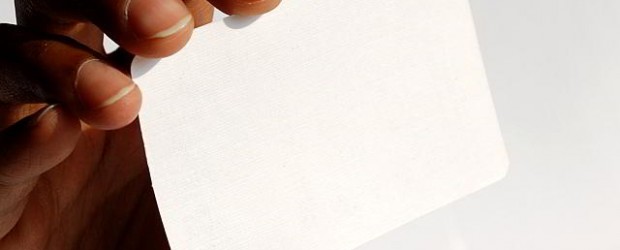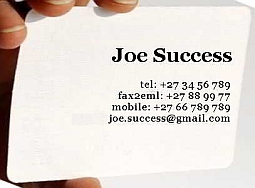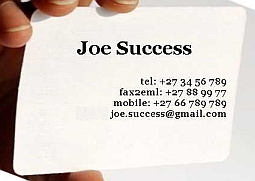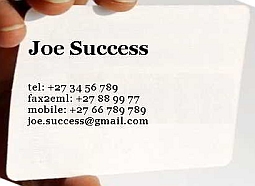(thanks to vivekchugh at sxc.hu for the free photo)
People developing a network marketing business ideally need two types of business cards… a simple contact card, and a business card.
contact card for prospects
If you’re talking with someone, giving your card at the end of the conversation in the hope the person will log on to your website, email you, or phone you about your business or products, is a waste of the card! Most business cards land in the waste-paper basket.
The purpose of your card is to help the other person remember you, and a means of contacting you if they want. Have your name, phone number, and generic email address on it, only.
Resist putting words like “independent GNLD Distributor” on your contact card. Many people will not be able to resist typing “GNLD” into Google search to find out what business you’re doing.
And they’ll often do a similar search if your email address is not generic… joe.success@gmail.com …but is linked to your website… joe.success@yourwebsite.co.za
Unfortunately, there’s a lot of ill-informed negativity about MLM, so as soon as “network marketing” appears on screen, your prospect will pre-judge your business based on the incorrect gossip he’s heard… and disappear over the horizon!
contact card design
Most human brains are wired to remember important info on the right-hand side of a page, so our eyes tend to go to the right-hand side of a page or a business card, first.
Stuff on the left-side of a page gets processed by the artistic part of the brain, is therefore seen as visually interesting… but not really important enough to remember.
The eye also finds blank space pleasing, so resit the temptation to fill the card or jazz it up with psychedelic colours and patterns.
Keep it simple.
Right-align your name, telephone numbers, email address.
Or if you prefer, centre your name and right-align the rest.
Everything left-aligned….
My eyes go to the empty space on the right first, and have to come back to the left to read. It doesn’t feel comfortable. How about your eyes?
Everything centred…
My eyes go straight to “Joe Success”, then have to re-focus to read the contact details… almost feels like I’ve gone cross-eyed in the attempt!
business card
This card is for people who know what you do… mainly, your customers. Similar design to the contact card, with the addition of your business name, your business email, and your website address.
Make it a habit to staple your business card to every product purchase receipt, so your customers know where to order replacements.
[It's also a good idea to stick a small label with your name and phone number onto the product container. Be careful not to obliterate any important information, and do take the trouble to stick the label on squarely. Crooked labels look as if you don't care.]
general card tips
Your prospect needs to put the card somewhere, so make it the size to fit into a credit-card slot in a wallet or purse.
Invest in a card holder. Scruffy, dog-eared cards do not convey a successful-person message.
Varnished front is okay, but keep the back unvarnished. Personally, I loathe getting a card that’s covered with plastic or varnished both sides, because it’s very difficult to write on.
When the person I’ve been chatting with has gone, before I forget, I like to jot on the back of the card the place we met, date, and time. And salient points about the person, for example: married, 2 kids @ school, her job, partner’s job, her business or product need, going holiday next week, when to contact again, and so on.
Carry writing implements with you. I find pencils best, because they write on most surfaces, can be used at any angle, and don’t leak ink into your pocket. A pen won’t write properly on some papers, and it won’t write for long unless it’s pointing downwards.
Have a small notebook handy, too. Not everyone has a business or contact card, and they’ll happily jot down their contact details if you offer them a pencil and your pocket notebook. Be generous… hand over a new clean page, so your contact doesn’t have to search for a space between other people’s details.
Black, or dark blue ink on white card looks professional. Dark blue ink on a pale yellow background also looks good, and helps your card stand out. Be careful with colours though, as they convey hidden, subconscious messages. Red for danger, green for Nature, dark blue for business calmness and sincerity are just three examples. It’s quite a science, so well worth googling and reading up on it as part of your business knowledge.
Ideally, it’s best to choose the thickest card you can afford. The thinking is that successful people have got money, and can afford good quality card. When we started, I printed on A4 card thin enough to fit into my printer, and trimmed the individual cards myself. Then, when I gave them out, I said cheerfully: “Excuse the card. It’s only temporary, while I’m having new cards printed.” ;-)
Choose a font size big enough to read easily.
Choose a font that people are used to seeing in books or online. Some modern font designs are as easy to read as a doctor’s prescription on a busy day.
Avoid block letters. It’s much easier to read these words, THAN IT IS TO READ THESE WORDS. That’s because people recognise the shape of words when they’re reading, and if the letters are all the same height, the automatic recognition doesn’t work.
Have a separate email address for each card. It’s easy to do this with free emails from Google, Yahoo, or Microsoft. For example… joe.success@gmail.com for the contact card, and joe.success@ymail.com for the business card. Then you’ll be able to see easily which card brings you the most contacts.
The free-download Open Office, as well as other word-processing software, have business cards in the template sections, so give it a try yourself. If you can design something you like, it may save you design costs at a print shop if you take it along on a usb-stick.
Often, print shops stipulate a minimum order of 1000 cards, so if you can print at home initially, it will give you a chance to use your design for a while to see if you like it. Then you won’t be stuck with 900 cards you don’t like.
Have fun!






Thank you very much for such an informative article, am looking forward to a great sale in product distribution this month. Do you provide an affiliate opportunity?
I am grateful. I believe this is going to change my business in a great way.
Hi
Thanks for the advice, but what will guys like myself whomdon`t ve a website do for the email address?
Good day
Hi Lovemore.
Thanks for visiting.
You don’t need a website to be successful in GNLD. Most people have a cellphone, and anyone can get a free email address, so putting those two on your card will enable people to get in touch with you.
If you want a website, a free WordPress website is a good way to start. Read about it here.
Best wishes,
David.